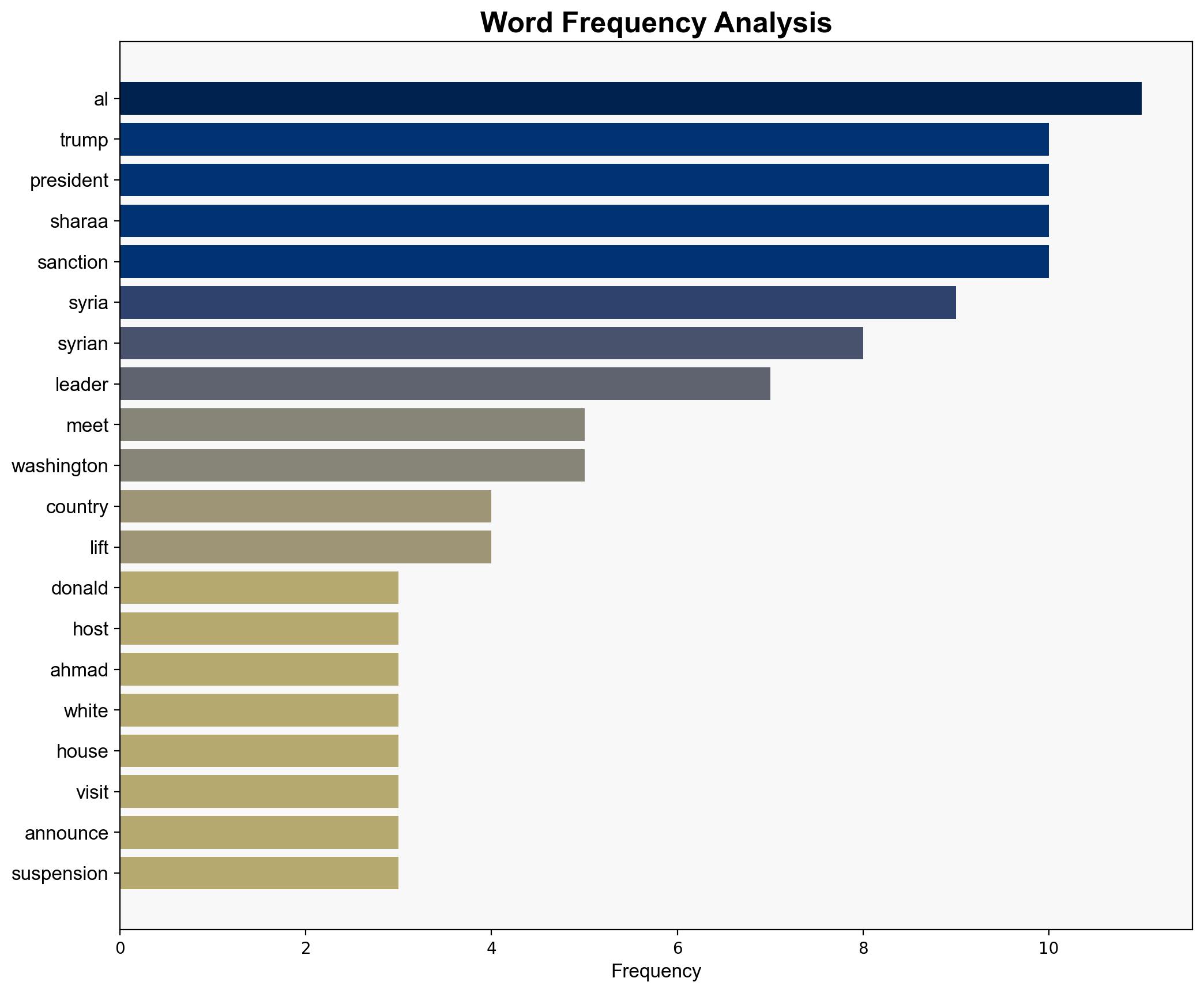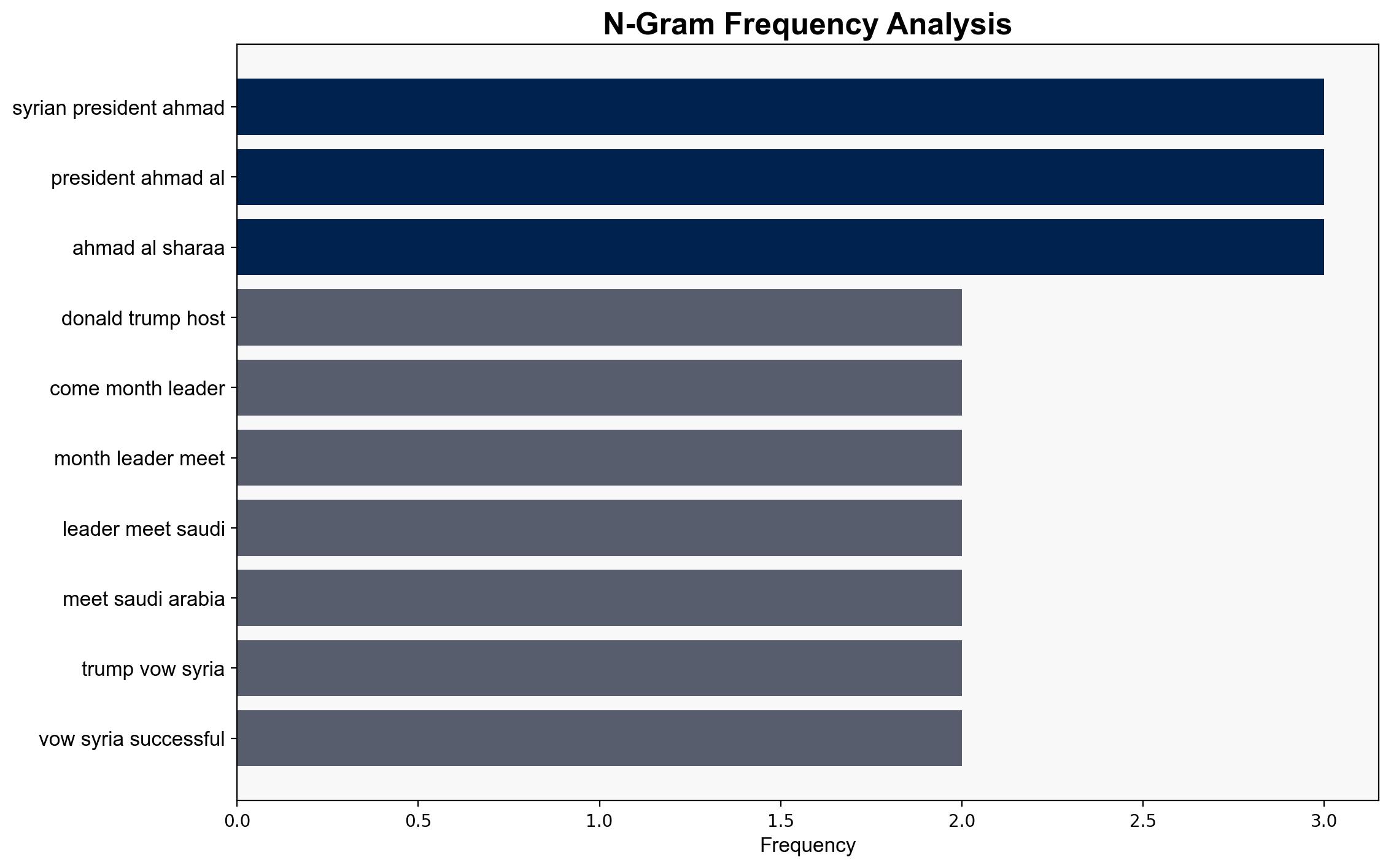Trump vows to ‘do everything’ to help Syria after meeting with leader – ABC News (AU)
Published on: 2025-11-11
AI-powered OSINT brief from verified open sources. Automated NLP signal extraction with human verification. See our Methodology and Why WorldWideWatchers.
Intelligence Report: Trump vows to ‘do everything’ to help Syria after meeting with leader – ABC News (AU)
1. BLUF (Bottom Line Up Front)
With a moderate confidence level, the most supported hypothesis is that the United States, under President Trump, is strategically realigning its Middle East policy to include Syria as a partner in regional stability efforts. This involves a calculated risk to lift sanctions and engage diplomatically with Syria’s interim leadership. Recommended actions include close monitoring of Syria’s internal developments and regional reactions, particularly from Israel and Saudi Arabia, to preempt any destabilizing moves.
2. Competing Hypotheses
Hypothesis 1: The U.S. is genuinely shifting its policy to support Syria’s reconstruction and regional integration, leveraging diplomatic engagement to stabilize the Middle East.
Hypothesis 2: The U.S. engagement with Syria is a tactical maneuver to counterbalance Iranian influence in the region and is not indicative of a long-term strategic partnership.
Hypothesis 1 is more likely, given the suspension of sanctions and the diplomatic overtures, suggesting a broader policy shift rather than a mere tactical adjustment.
3. Key Assumptions and Red Flags
Assumptions: The U.S. believes that engaging with Syria will lead to regional stability. Syria’s interim leadership is capable of maintaining control and pursuing moderate policies.
Red Flags: Al Sharaa’s past militant ties and the possibility of deception regarding Syria’s true intentions. The muted welcome at the White House could indicate internal U.S. dissent or caution.
4. Implications and Strategic Risks
The lifting of sanctions could lead to increased foreign investment in Syria, potentially stabilizing the region economically. However, it risks alienating traditional U.S. allies like Israel and Saudi Arabia, who may view this as a threat to their security. The potential for Syria to re-align with adversarial powers like Iran remains a significant risk, which could escalate regional tensions.
5. Recommendations and Outlook
- Continue diplomatic engagement with Syria while maintaining strict oversight on compliance with international norms.
- Coordinate with regional allies to ensure a unified approach to Middle East stability.
- Best-case scenario: Successful integration of Syria into the international community, leading to regional stability.
- Worst-case scenario: Syria exploits U.S. engagement to strengthen ties with adversarial powers, destabilizing the region.
- Most-likely scenario: A cautious and gradual improvement in U.S.-Syria relations with ongoing regional tensions.
6. Key Individuals and Entities
Donald Trump, Ahmad Al Sharaa, U.S. Treasury Department, Congress, World Bank, United Nations Security Council.
7. Thematic Tags
Middle East Policy, U.S.-Syria Relations, Sanctions, Regional Stability
Structured Analytic Techniques Applied
- Causal Layered Analysis (CLA): Analyze events across surface happenings, systems, worldviews, and myths.
- Cross-Impact Simulation: Model ripple effects across neighboring states, conflicts, or economic dependencies.
- Scenario Generation: Explore divergent futures under varying assumptions to identify plausible paths.
Explore more:
Regional Focus Briefs ·
Daily Summary ·
Methodology





